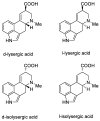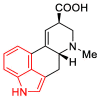Methods of Lysergic Acid Synthesis-The Key Ergot Alkaloid
- PMID: 36364148
- PMCID: PMC9654825
- DOI: 10.3390/molecules27217322
Methods of Lysergic Acid Synthesis-The Key Ergot Alkaloid
Abstract
Ergot is the spore form of the fungus Claviceps purpurea. Ergot alkaloids are indole compounds that are biosynthetically derived from L-tryptophan and represent the largest group of fungal nitrogen metabolites found in nature. The common part of ergot alkaloids is lysergic acid. This review shows the importance of lysergic acid as a representative of ergot alkaloids. The subject of ergot and its alkaloids is presented, with a particular focus on lysergic acid. All methods of total lysergic acid synthesis-through Woodward, Hendrickson, and Szantay intermediates and Heck coupling methods-are presented. The topic of biosynthesis is also discussed.
Keywords: biosynthesis; ergot alkaloids; lysergic acid; total synthesis.
Conflict of interest statement
The authors declare no conflict of interest. The funders had no role in the design of the study; in the collection, analyses, or interpretation of data; in the writing of the manuscript; or in the decision to publish the results.
Figures







































































































Similar articles
-
Combinatorial assembly of simple and complex D-lysergic acid alkaloid peptide classes in the ergot fungus Claviceps purpurea.J Biol Chem. 2009 Mar 13;284(11):6650-60. doi: 10.1074/jbc.M807168200. Epub 2009 Jan 12. J Biol Chem. 2009. PMID: 19139103 Free PMC article.
-
Biosynthesis of the Pharmaceutically Important Fungal Ergot Alkaloid Dihydrolysergic Acid Requires a Specialized Allele of cloA.Appl Environ Microbiol. 2017 Jun 30;83(14):e00805-17. doi: 10.1128/AEM.00805-17. Print 2017 Jul 15. Appl Environ Microbiol. 2017. PMID: 28476772 Free PMC article.
-
D-lysergic acid activation and cell-free synthesis of D-lysergyl peptides in enzyme fractions from the ergot fungus Claviceps purpurea.Biochemistry. 1988 Aug 9;27(16):6164-70. doi: 10.1021/bi00416a051. Biochemistry. 1988. PMID: 2847788
-
Biosynthetic pathways of ergot alkaloids.Toxins (Basel). 2014 Dec 10;6(12):3281-95. doi: 10.3390/toxins6123281. Toxins (Basel). 2014. PMID: 25513893 Free PMC article. Review.
-
Progress and prospects of ergot alkaloid research.Adv Biochem Eng Biotechnol. 2000;68:1-20. doi: 10.1007/3-540-45564-7_1. Adv Biochem Eng Biotechnol. 2000. PMID: 11036684 Review.
Cited by
-
Ergot alkaloid control in biotechnological processes and pharmaceuticals (a mini review).Front Toxicol. 2024 Oct 8;6:1463758. doi: 10.3389/ftox.2024.1463758. eCollection 2024. Front Toxicol. 2024. PMID: 39439532 Free PMC article. Review.
-
The C-8-S-isomers of ergot alkaloids - a review of biological and analytical aspects.Mycotoxin Res. 2024 Feb;40(1):1-17. doi: 10.1007/s12550-023-00507-0. Epub 2023 Nov 13. Mycotoxin Res. 2024. PMID: 37953416 Free PMC article. Review.
-
Recent Advances in the Detection of Food Toxins Using Mass Spectrometry.Chem Res Toxicol. 2023 Dec 18;36(12):1834-1863. doi: 10.1021/acs.chemrestox.3c00241. Epub 2023 Dec 7. Chem Res Toxicol. 2023. PMID: 38059476 Free PMC article. Review.
-
Molecular Mechanisms of Nicergoline from Ergot Fungus in Blocking Human 5-HT3A Receptor.J Microbiol Biotechnol. 2024 Nov 29;35:e2411020. doi: 10.4014/jmb.2411.11020. J Microbiol Biotechnol. 2024. PMID: 39849925 Free PMC article.
-
Unveiling nonribosomal peptide synthetases from the ergot fungus Claviceps purpurea involved in the formation of diverse ergopeptines.Acta Pharm Sin B. 2025 Jun;15(6):3321-3337. doi: 10.1016/j.apsb.2025.03.022. Epub 2025 Mar 13. Acta Pharm Sin B. 2025. PMID: 40654343 Free PMC article.
References
-
- Ochodzki P., National Research Institute . Zapobieganie Zagrożeniom Związanym z Występowaniem w Ziarnie Zbóż Alkaloidów Pasożytniczego Grzyba Buławinki Czerwonej (Sporysz)—Prevention of Risks Associated with the Presence of Alkaloids in the Cereal Grain Parasitic Fungus of Ergot. Expertise; Radzików, Poland: 2015.
-
- Berde B., Schild H.O., editors. Ergot Alkaloids and Related Compounds. Springer; Berlin/Heidelberg, Germany: 1978.
Publication types
MeSH terms
Substances
Grants and funding
LinkOut - more resources
Full Text Sources

